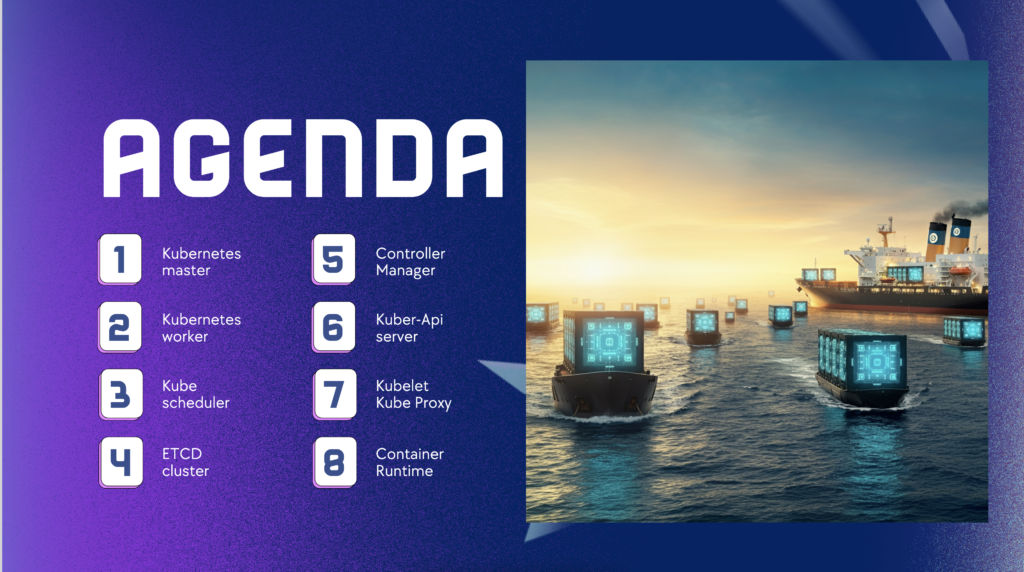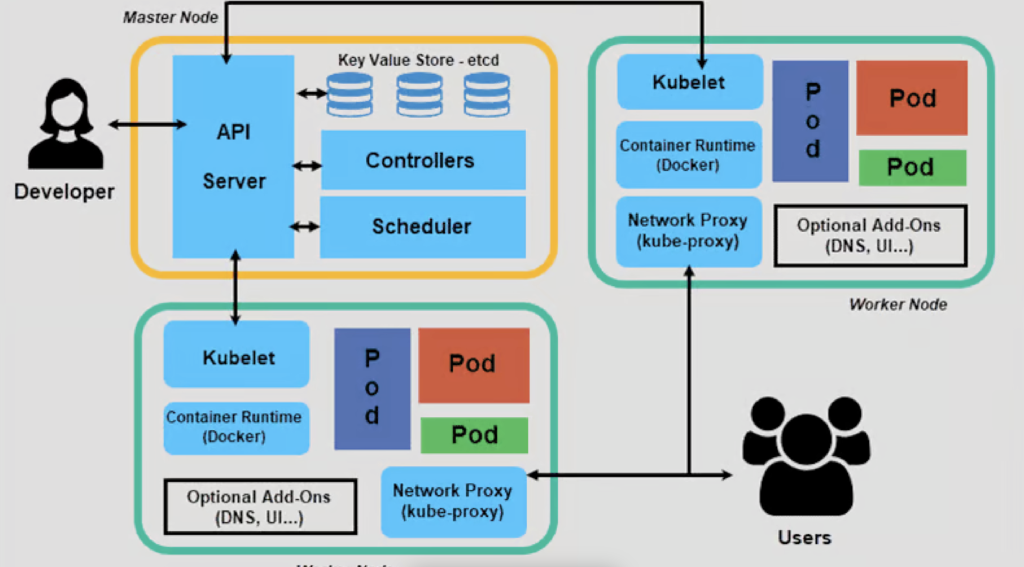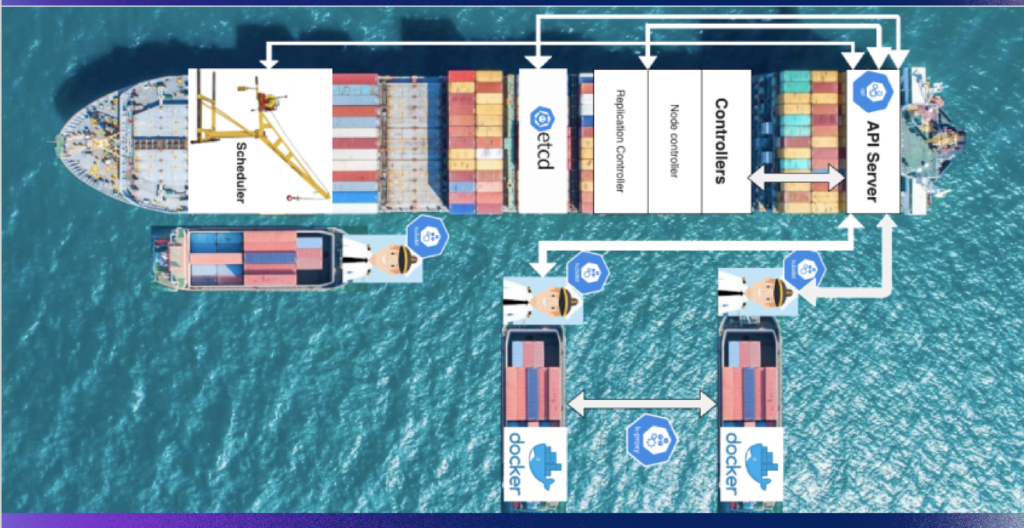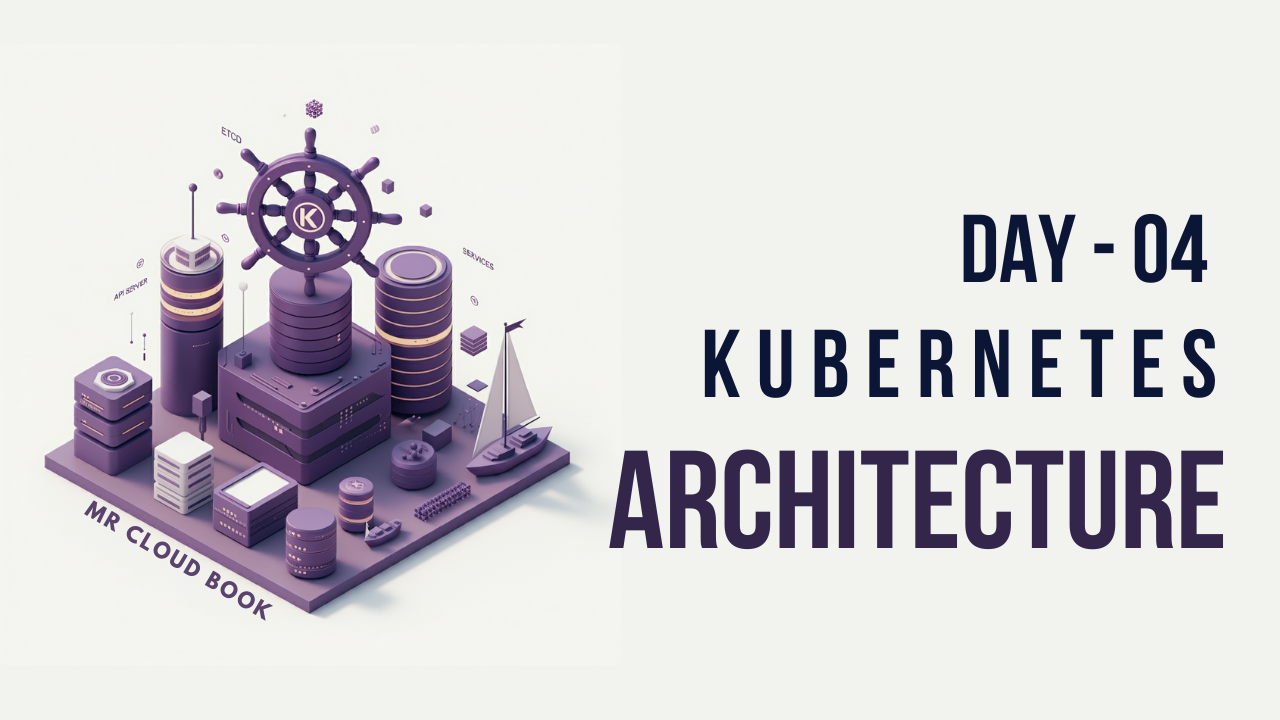Introduction
In the ever-evolving landscape of cloud-native technologies, Kubernetes has emerged as the de facto standard for container orchestration. Like a well-orchestrated symphony of shipping containers navigating vast oceans, Kubernetes manages and coordinates containerized applications with remarkable precision and efficiency.
The Core Components: A Deep Dive
1. Kubernetes Master (Control Plane)
At the heart of every Kubernetes cluster lies the master node, often called the control plane. Think of it as the captain’s bridge on a massive container ship – it’s where all critical decisions are made. The master node maintains the desired state of your cluster, making global decisions about scheduling, deployments, and responding to cluster events.
2. Kubernetes Worker Nodes
Worker nodes are the workhorses of the Kubernetes ecosystem. Like individual cargo ships in a fleet, these nodes host the actual applications and workloads. Each worker node is capable of running multiple pods, scaling your applications as needed.
3. Kube Scheduler
The scheduler is Kubernetes’ logistics department. It watches for newly created pods with no assigned nodes and selects the perfect node for them to run on. This decision-making process takes into account resources, hardware/software constraints, and various other parameters.
4. ETCD Cluster
ETCD serves as the cluster’s brain – a distributed key-value store that reliably stores the entire cluster’s configuration data. It’s like the ship’s log book, maintaining consistent records of all cluster states and configurations.
5. Controller Manager
The Controller Manager is like the fleet’s operations center, running controllers that regulate the state of the cluster. From replication controllers to endpoint controllers, it ensures that the desired state matches the current state of the cluster.
6. Kube-API Server
Acting as the cluster’s front desk, the API server validates and processes all REST requests, modifying the corresponding objects in ETCD. It’s the primary management point for the entire cluster, handling internal and external requests.
7. Kubelet and Kube Proxy
These components work at the node level:Kubelet: The node agent that ensures containers are running in podsKube Proxy: Maintains network rules and enables communication between pods.
8. Container Runtime
The container runtime is the software responsible for running containers. Like the engines of our container ships, it powers the actual execution of containers, with Docker being one of the most popular options.

Kubernetes
Kubernetes is a powerful open-source container orchestration platform that automates the deployment, scaling, and management of containerized applications. Originally developed by Google and now maintained by the Cloud Native Computing Foundation (CNCF), Kubernetes has become the industry standard for container orchestration. It acts as an intelligent management system that ensures your applications run exactly as intended, regardless of the underlying infrastructure. Just as a conductor coordinates an orchestra, Kubernetes coordinates containers across a cluster of machines, handling complex tasks like load balancing, storage orchestration, automated rollouts and rollbacks, and self-healing. It enables organizations to manage containerized workloads and services efficiently, facilitating both declarative configuration and automation. Whether you’re running applications in the cloud, on-premises, or in a hybrid environment, Kubernetes provides the tools and abstractions necessary to deploy, maintain, and scale applications with confidence. Its robust ecosystem and widespread adoption have made it the backbone of modern cloud-native applications, supporting everything from simple web applications to complex microservices architectures.

Kubernetes Ship analogy
The image presents a sophisticated visualization of Kubernetes architecture through a maritime shipping analogy, offering a clear understanding of how container orchestration works in practice. The large container ship at the top represents the Kubernetes Control Plane (Master Node), which houses critical components essential for cluster management. This includes the Scheduler (depicted as a loading crane) that makes intelligent decisions about where to place containers, similar to how a harbor master decides where to position ships and cargo. The ETCD component serves as the cluster’s central database, maintaining crucial information about the state and configuration of the entire system, much like a ship’s manifest tracks all cargo locations. The Controllers act as fleet managers, ensuring that the desired state of operations is maintained across the cluster, while the API Server functions as the command center, processing all communications and orchestrating activities throughout the system.Below the master ship, multiple smaller vessels represent Worker Nodes, each running Docker (symbolized by the Docker whale logo) as their container runtime environment. These worker nodes are interconnected through a sophisticated network (illustrated by white arrows), enabling seamless communication and coordination between different parts of the cluster. Each worker node can host multiple containers (shown as stacked cargo containers), and Kubernetes manages their deployment, scaling, and networking. The blue hexagonal Kubernetes logos scattered throughout the image indicate the presence of Kubernetes control mechanisms at various points in the system, ensuring smooth operation and management of the containerized applications.This maritime analogy effectively demonstrates how Kubernetes orchestrates complex containerized environments, managing resources, ensuring high availability, and maintaining system stability, much like how a modern shipping port coordinates the movement of thousands of containers across multiple vessels. The visualization helps understand how Kubernetes handles the complexities of modern cloud-native applications, from load balancing and service discovery to storage orchestration and automated rollouts.


Leave a Reply